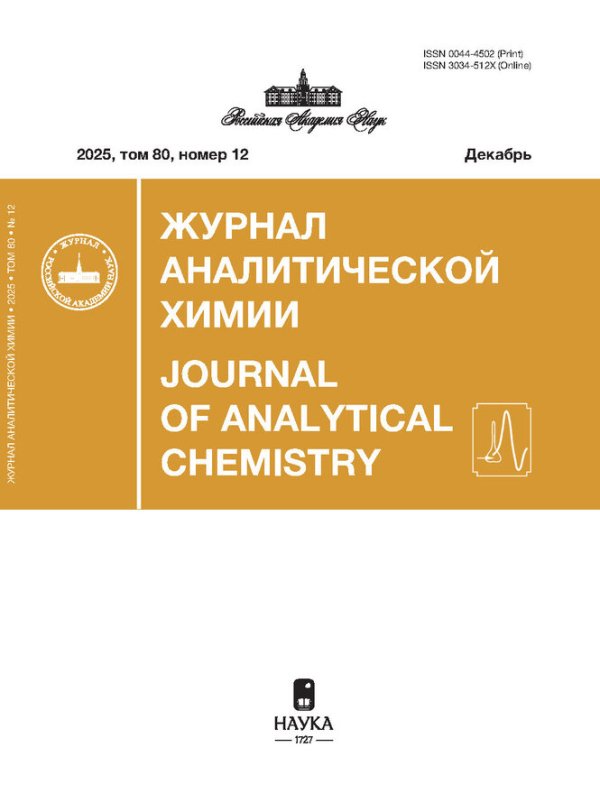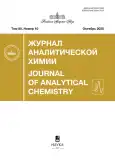Применение фиктивных аналогов для получения бионеорганического сорбента, модифицированного импринтированными белками
- Авторы: Пресняков К.Ю.1, Ильичева П.М.1, Цюпка Д.В.1, Меняйло И.Е.1, Бурмистрова Н.А.1, Пиденко П.С.1
-
Учреждения:
- Саратовский государственный университет им. Н.Г. Чернышевского, Институт химии
- Выпуск: Том 80, № 10 (2025)
- Страницы: 1045-1055
- Раздел: ОРИГИНАЛЬНЫЕ СТАТЬИ
- Статья получена: 06.10.2025
- URL: https://bakhtiniada.ru/0044-4502/article/view/318321
- DOI: https://doi.org/10.7868/S3034512X25100032
- ID: 318321
Цитировать
Аннотация
Разработана методика получения специфичного бионеорганического сорбента на основе частиц оксида кремния(IV), модифицированных импринтированным белком (ИБ). Бычий сывороточный альбумин использован в качестве матричной белковой молекулы. Получение ИБ проведено в присутствии ряда молекул-шаблонов (кумарина, 4-гидроксикумарина, кверцетина, 5,7-диметоксикумарина), являющихся фиктивными аналогами микотоксина зеараленона. Для предварительной оценки возможности замены зеараленона на фиктивные аналоги, а также выбора оптимальной концентрации молекул-шаблонов при получении ИБ использованы методы компьютерной химии (молекулярный докинг, молекулярная динамика). Показана необходимость предварительной модификации поверхности частиц оксида кремния(IV) для получения сорбентов на основе ИБ. Доказана возможность применения бионеорганических сорбентов для твердофазной экстракции молекул-шаблонов из модельных растворов кумарина (Q = 2.0 мг/г), 4-гидроксикумарина (Q = 1.2 мг/г), кверцетина (Q = 0.8 мг/г), 5,7-диметоксикумарина (Q = 2.2 мг/г) и зеараленона (ЗЕА) из экстракта пшеницы (Q = 4.79 мг/г, ИФ = 2.45). Построены изотермы сорбции ЗЕА на модифицированные ИБ сорбенты, полученные в присутствии различных фиктивных аналогов. Изучена цитотоксичность ИБ и проведена оценка биобезопасности с помощью инструмента AGREEMIP.
Ключевые слова
Об авторах
К. Ю. Пресняков
Саратовский государственный университет им. Н.Г. Чернышевского, Институт химии
Email: pidenkops@gmail.com
ул. Астраханская, 83, Саратов, 410012 Россия
П. М. Ильичева
Саратовский государственный университет им. Н.Г. Чернышевского, Институт химии
Email: pidenkops@gmail.com
ул. Астраханская, 83, Саратов, 410012 Россия
Д. В. Цюпка
Саратовский государственный университет им. Н.Г. Чернышевского, Институт химии
Email: pidenkops@gmail.com
ул. Астраханская, 83, Саратов, 410012 Россия
И. Е. Меняйло
Саратовский государственный университет им. Н.Г. Чернышевского, Институт химии
Email: pidenkops@gmail.com
ул. Астраханская, 83, Саратов, 410012 Россия
Н. А. Бурмистрова
Саратовский государственный университет им. Н.Г. Чернышевского, Институт химии
Email: pidenkops@gmail.com
ул. Астраханская, 83, Саратов, 410012 Россия
П. С. Пиденко
Саратовский государственный университет им. Н.Г. Чернышевского, Институт химии
Автор, ответственный за переписку.
Email: pidenkops@gmail.com
ул. Астраханская, 83, Саратов, 410012 Россия
Список литературы
- Narvaez A., Castaldo L., Izzo L., Pallares N., Rodriguez-Carrasco Y., Ritieni A. Deoxynivalenol contamination in cereal-based foodstuffs from Spain: Systematic review and meta-analysis approach for exposure assessment // Food Control. 2022. V. 132. Article 108521. https://doi.org/10.1016/j.foodcont.2021.108521
- Khaneghah A.M., Fakhri Y., Raeisi S., Armoon B., Sant'Ana A.S. Prevalence and concentration of ochratoxin A, zearalenone, deoxynivalenol and total aflatoxin in cereal-based products: A systematic review and meta-analysis // Food Chem. Toxicol. 2018. V. 118. P. 830. https://doi.org/10.1016/j.fct.2018.06.037
- Ullah S., Ali S., Rezende V.T., Nabi G., Tonin F.G., de Oliveira C.A.F. Global occurrence and levels of mycotoxins in infant foods: A systematic review (2013–2024) // Food Control. 2025. V. 171. Article 111135. https://doi.org/10.1016/j.foodcont.2025.111135
- Tam J., Mankotia M., Mably M., Pantazopoulos P., Neil R.J., Calwa P., Scott P.M. Survey of breakfast and infant cereals for aflatoxins B1, B2, G1 and G2 // Food Addit. Contam. 2006. V. 23. № 7. P. 693. https://doi.org/10.1080/02652030600627230
- Технический регламент Таможенного союза “О безопасности зерна” (ТР ТС 015/2011) clck.ru/33utzE (дата обращения 13.03.2025).
- Li X., Wang M.Y., Wang Y., Yang W.Z., Yang C.X. Fabrication of amino- and hydroxyl dual-functionalized magnetic microporous organic network for extraction of zearalenone from traditional Chinese medicine prior to the HPLC determination // J. Chromatogr. A. 2024. V. 1724. Article 464915. https://doi.org/10.1016/j.chroma.2024.464915
- Zhang B., Liu W., Liu Z., Fu X., Du, D. High-performance liquid chromatography for the sensitive zearalenone determination by the automated immunomagnetic beads purifier for one-step sample pre-treatment // Eur. Food Res. Technol. 2022. V. 248. № 1. P. 109. https://doi.org/10.1007/s00217-021-03862-3
- Fu H., Xu W., Wang H., Liao S., Chen, G. Preparation of magnetic molecularly imprinted polymers for the identification of zearalenone in grains // Anal. Bioanal. Chem. 2020. V. 412. № 19. P. 4725. https://doi.org/10.1007/s00216-020-02729-y
- Diab M.A., El-Sabban H.A., Baek K.-H. Recent advances in zearalenone clean-up approaches from polluted food and feed: A mini-review of the State-of-the-art developments // Microchem. J. 2024. V. 207. Article 112182. https://doi.org/10.1016/j.microc.2024.112182
- Song L., Zhang J., Wang M., Huang Z., Zhang Y., Zhang X., Liang Yu., He J. Simultaneously selective separation of zearalenone and four aflatoxins from rice samples using co-pseudo-template imprinted polymers with MIL-101(Cr)-NH2 as core // J. Chromatogr. Sci. 2024. V. 62. № 9. P. 892. https://doi.org/10.1093/chromsci/bmae041
- Hu M., Ge W., Liu X., Zhu Y. Preconcentration and determination of zearalenone in corn oil by a one-step prepared polydopamine-based magnetic molecularly imprinted polymer (MIP) with high-performance liquid chromatography with fluorescence (HPLC-FLD) detection // Anal. Lett. 2022. V. 55. № 3. P. 343. https://doi.org/10.1080/00032719.2021.1931268
- Calahorra-Rio L., Guadaño-Sánchez M., Moya-Cavas T., Urraca, J.L. Magnetic core-shell nanoparticles using molecularly imprinted polymers for zearalenone determination // Molecules. 2022. V. 27. № 23. Article 8166. https://doi.org/10.3390/molecules27238166
- Fu H., Liu J., Xu W., Wang H., Liao S., Chen G. A new type of magnetic molecular imprinted material combined with β-cyclodextrin for the selective adsorption of zearalenone // J. Mater. Chem. B. 2020. V. 8. № 48. P. 10966. https://doi.org/10.1039/D0TB02146F
- Gutierrez R.A.V., Hedström M., Mattiasson B. Bioimprinting as a tool for the detection of aflatoxin B1 using a capacitive biosensor // Biotechnol. Rep. 2016. V. 11. P. 12. https://doi.org/10.1016/j.btre.2016.05.006
- Sakamoto S., Minami K., Nuntawong P., Yusakul G., Putalun W., Tanaka H., Fujii S., Morimoto S. Bioimprinting as a Receptor for Detection of Kwakhurin // Biomolecules. 2022. V. 12. № 8. Article 1064. https://doi.org/10.3390/biom12081064
- Пиденко П.С., Пресняков К.Ю., Дрозд Д.Д., Бурмистрова Н.А. Селективные сорбенты на основе импринтированной глюкозооксидазы // Журн. аналит. химии. 2023. Т. 78. № 9. С. 807. (Pidenko P.S., Presnyakov K.Y., Drozd D.D., Burmistrova N.A. Selective adsorbents based on imprinted glucose oxidase // J. Anal. Chem. 2023. V. 78. № 9. P. 1146. https://doi.org/10.1134/S1061934823090101)
- Marć M., Wojnowski W., Pena-Pereira F., Tobiszewski M., Martín-Esteban A. AGREEMIP: The analytical greenness assessment tool for molecularly imprinted polymers synthesis // ACS Sustain. Chem. Eng. 2024. V. 12. № 33. P. 12516. https://doi.org/10.1021/acssuschemeng.4c03874
- Ilicheva P.M., Fedotova E.S., Presnyakov K.Y., Grinev V.S., Pidenko P.S., Burmistrova N.A. Theoretical design of imprinted albumin against foodborne toxins // Mol. Syst. Des. Eng. 2024. V. 9. № 5. P. 456. https://doi.org/10.1039/D3ME00179B
- Morris G.M., Huey R., Lindstrom W., Sanner M.F., Belew R.K., Goodsell D.S., Olson A.J. AutoDock4 and AutoDockTools4: Automated docking with selective receptor flexibility // J. Comput. Chem. 2009. V. 30. № 16. P. 2785. https://doi.org/10.1002/jcc.21256
- Hess B., Kutzner C., Van Der Spoel D., Lindahl E. GROMACS 4: Algorithms for highly efficient, load-balanced, and scalable molecular simulation // J. Chem. Theory Comput. 2008. V. 4. № 3. P. 435. https://doi.org/10.1021/ct700301q
- Beloglazova N., Lenain P., Tessier M., Goryacheva I., Hens, Z., De Saeger S. Bioimprinting for multiplex luminescent detection of deoxynivalenol and zearalenone // Talanta. 2019. V. 192. P. 169. https://doi.org/10.1016/j.talanta.2018.09.042
- Pidenko P., Zhang H., Lenain P., Goryacheva I., De Saeger, S., Beloglazova N. Imprinted proteins as a receptor for detection of zearalenone // Anal. Chim. Acta. 2018. V. 1040. P. 99. https://doi.org/10.1016/j.aca.2018.07.062
- Drozd D.D., Byzova N.A., Pidenko P.S., Tsyupka D.V., Strokin P.D., Goryacheva O.A., Zherdev A.V., Goryacheva I.Yu. Dzantiev B.B. Luminescent alloyed quantum dots for turn-off enzyme-based assay // Anal. Bioanal. Chem. 2022. V. 414. № 15. P. 4471. https://doi.org/10.1007/s00216-022-04016-4
- Lucci P., Derrien D., Alix F., Pérollier, C., Bayoudh, S. Molecularly imprinted polymer solid-phase extraction for detection of zearalenone in cereal sample extracts // Anal. Chim. Acta. 2010. V. 672. № 1. P. 15. https://doi.org/10.1016/j.aca.2010.03.010
- Presnyakov K.Y., Ilicheva P.M., Tsyupka D.V., Khudina E.A., Pozharov M.V., Pidenko P.S., Burmistrova N.A. Dummy-template imprinted bovine serum albumin for extraction of zearalenone // Mikrochim. Acta. 2024. V. 191. № 12. P. 767. https://doi.org/10.1007/s00604-024-06790-7
- PubChem. Quercetin. clck.ru/3Ha3cT (дата обращения: 13.03.2025).
Дополнительные файлы











